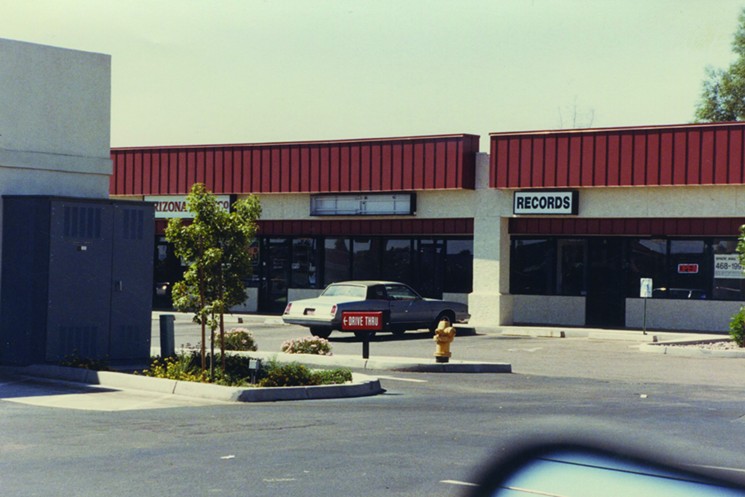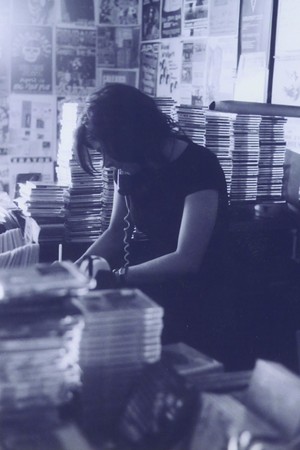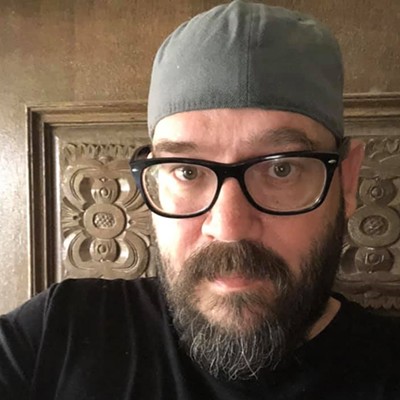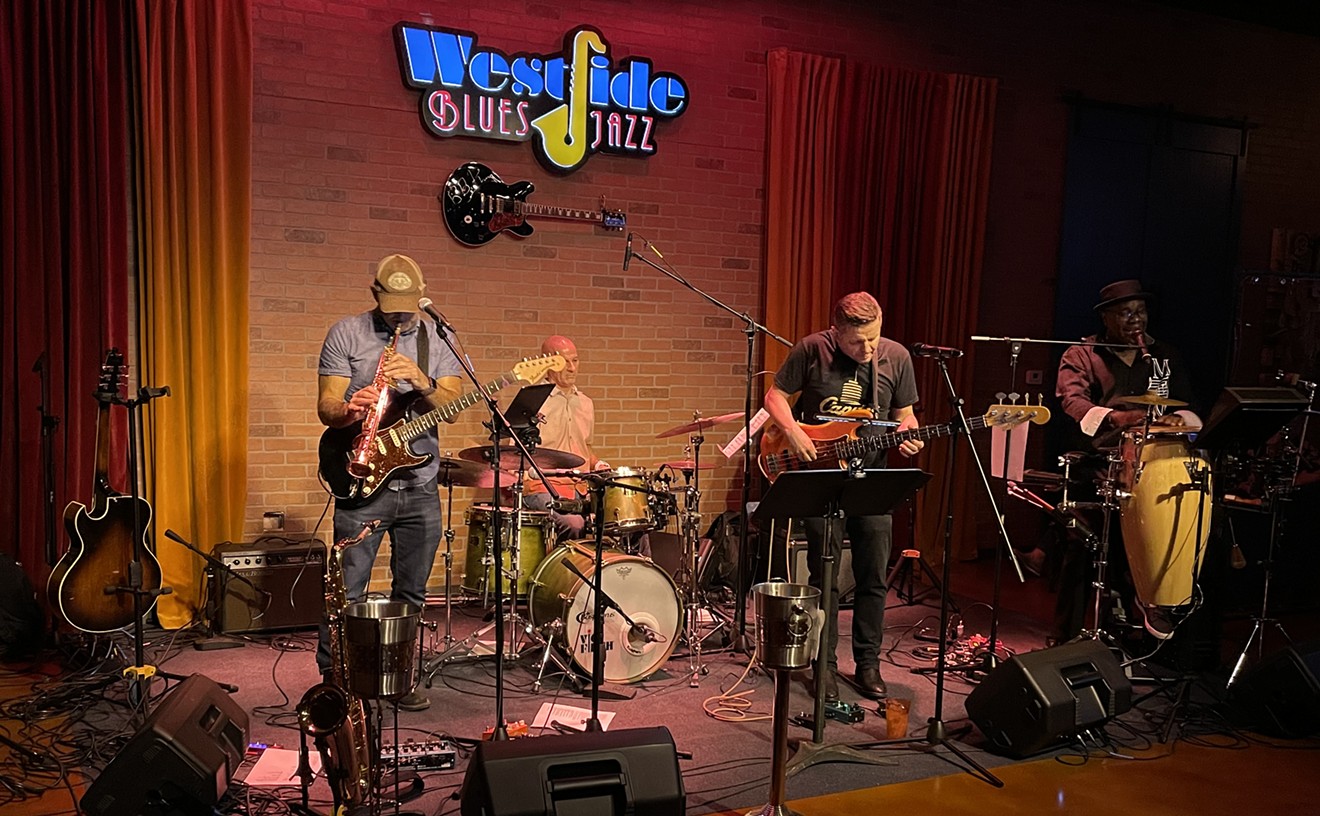It’s the night before Record Store Day 2017 in April, and the interior of her particular record store is a hive of activity. In a little more than 12 hours, a horde of customers will fill the place in search of freebies, exclusives, rarities, and finds. Right now, the Stinkweeds staff, including manager Lindsay Cates and longtime employee Dario Miranda, are the ones going full-tilt boogie inside the store as they arrange goodie bags, open boxes, and make other preparations for what lies ahead.
Lanning, however, is more interested in the past at the moment. Standing behind the store’s counter, she flips through a small photo album containing pictures of the store from some 30-odd years.
She comes across a few of Stinkweeds’ original home. They date back to 1987.
“This is a photo of our first location on Dobson and Guadalupe in Mesa,” Lanning says, pointing out a photo of the store’s relatively spartan exterior featuring a simple black-and-white sign with the word “RECORDS” on it. “It was behind an El Pollo Loco and next to a Little Caesars Pizza in the most drab and basic strip mall you could possibly imagine.”
Needless to say, both the store and its owner have come a long way since those days.
Over the past three decades, Stinkweeds has become one of the Valley’s most esteemed record stores, beloved by local audiophiles, vinyl junkies, indie geeks, and music fans alike, as well as any number of artists and musicians. The same could be said of Lanning, who is as much a part of Stinkweeds as its bins of records.
“The store is Kimber; Kimber is the store,” says Cates. “I can't picture Stinkweeds without her.”
Lanning’s been the heart and soul of Stinkweeds and the driving force behind its success since its debut 30 years ago.
At the age of 19, Lanning quit her longtime job at Zia Record Exchange, dropped out of Arizona State University, sold pretty much everything she owned, and opened its first location in Mesa on May 1, 1987, along with her boyfriend at the time.
She’s been running the place ever since, steering it through the ups and downs of the record store business, the ever-fickle music industry, and the whims of the local scene, not to mention three separate moves. And she did it with a mix of wisdom, wherewithal, ingenuity, and determination. Her impeccable taste in music probably helped as well, as did her endless energy and fierce attitude.
“I guess my main thing is that I've been scrappy in the way that I've been able to make it all work,” she says.
Stinkweeds’ success helped establish Lanning as a DIY icon, small business and cultural champion, and influential figure. It also served as a springboard for her other passion projects, like the Roosevelt Row gallery space Modified Arts and the small-business advocacy group Local First Arizona.
Lanning’s earned plenty of friends and fans from her exploits over the years, many of whom have a multitude of tales to tell about the Stinkweeds owner, her ferocious spirit, and her famed establishment. New Times got to hear some of these stories recently when assembling an oral history of the store in honor of its 30th anniversary.
(Editor's note: Some quotes have been condensed and edited for brevity and clarity.)
Kimber Lanning, Stinkweeds Records owner: My mother was very entrepreneurial, so I went to work for her when I was 12 in her art gallery. My mother was a really tough person to learn from and it’s not easy to sell art when you're 12. A few years later, I got my first job at Zia's when I was 15. I used to have my dad park around the corner, because I didn't want anybody knowing that I wasn't old enough to drive.
Michael Pawlicki, Eastside Records owner: I worked with Kimber in 1985 when I managed the original Zia’s at Indian School Road and 19th Avenue. Right away, she was like the best worker ever. Just this incredibly driven person. Very smart and very hard-working. Very no-nonsense. Most of our employees were goofballs and half-assed about everything. She was, immediately, someone who got stuff done and did it right. You probably didn't even have to ask her to do anything, it just got done.
Hank Fries, former Stinkweeds employee: I was the import buyer at the old Tower Records in Tempe in the mid-’80s. And because I was a record clerk, I kinda heard about of Kimber when she worked at Zia. She also did the old Zia radio show.
Pawlicki: [Zia Records founder Brad Singer] hired good people. A lot of smart, funny people back then. Brad was also a very driven businessperson, and I think that rubbed off on Kimber. In that age, it could be a tense place to work. He could be quite a bit demanding and kind of had a temper to him.
Lanning: I was helping with everything there, holding the store together. And when I got looked over for a management position, I asked Brad why he wouldn't consider me for a manager. He laughed and said, "Nobody will ever listen to a 100-pound woman." And so, I decided that I was miserable at ASU and I decided that I was going to make a go for it.
Pawlicki: Kimber’s the kind of person, if she wants to do something she's probably going to do it. When she quit, I was sorry to see her go. I don't think I knew immediately she was opening a store, which is what everyone who left Zia's around then was doing. Me and Ben [Wood] and Clayton [Agent] were all managers over at Zia, and they left and started Eastside.
Lanning: I didn't have a whole lot of money. I think I'd saved $5,000 or something like that. I had this huge record collection I'd amassed, partly from working at Zia and partly from collecting since I was about 12 or 13.
Pawlicki: She started out pretty small and humble with probably her own private record collection.
Lanning: I used to drive to LA a lot with my boyfriend at that time, Scott, to buy records. There were about 20 really great record stores in LA and we'd hit like seven in one day. So we just decided to open a store together and I guess it made perfect sense to me.
Fries: The original store was tiny, like the size of a small living room.
Lanning: It was behind an El Pollo Loco and next to a Little Caesars Pizza in the most drab and basic strip mall you could possibly imagine. I remember calling the number in the window, and the guy told me it was $18 a square foot. So I asked him, “Why is it $18 when the guy across the street has something for $12?” And he went, “Oh, really?" I kind of went around and worked on these guys and I ended up with $6 a square foot the first year.
Pawlicki: She's always been very hard-working and smart, almost ferocious at times.
Lanning: My brothers helped us build the record bins [out of] particle board. We sold all of our own records. A lot of my friends showed up on the first day or two to buy everything and I said, "If you're really my friend, you won't buy everything." And people thought that was confusing, like the point of opening up a record store is to sell stuff and I was telling them, "You can't buy more than three things unless you bring me trade." Because if I didn't have cool used stuff all the time, then people wouldn't come back anymore. I just sold all my stuff in the first three days, I'd be done. Closed up. Gone.
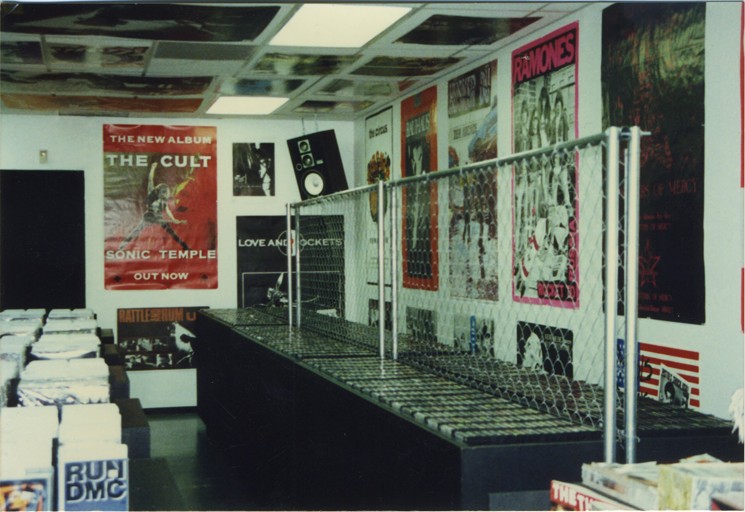
The interior of the original Stinkweeds in Mesa, which was open from 1987 to 1989.
Courtesy of Kimber Lanning
Pawlicki: I went there probably the first week they opened. It was very clean, nicely kept. They were both into different types of music and had a lot of that kind of stuff. I was a voracious used record buyer, so I went everywhere trying to find crazy stuff and Stinkweeds was certainly a regular stop for me. She was on that arty end of things, more the English things and the artier indie bands. When we met, [she was] really into a lot of British imports, kinda like OMD and things like that.
Lanning: When we opened, bands like The Cure and Depeche Mode were somewhat rare. To find New Order or The Smiths on CD when we opened was rare. We were the only ones who had that stuff, because CDs were brand-new and those were imports.
Fries: It was like new American indie punk rock mixed with classic British punk rock. There was just a ton of stuff. They carried a lot of import stuff, and as an import buyer I knew how much this stuff cost, and they were paying an almost nonexistent margin. And I think everyone could tell they weren't getting rich.
Lanning: We made the store stickers on shelf paper that we ran through the copy machine and we cut them out to size. That was also a cheap way to get the word out. Another thing I did was taking bright neon red squares, put one letter on each one, and pounded 'em in on the side of the road so you'd drive by and see "S-T-I-N-K-W-E-E-D-S” all the way down the road. People would always comment on that, "I saw your sign and thought it was really cool."
Fries: If they had to do something, they'd figure out how to do it super cheap, kind of maximizing their bang for their buck.
Lanning: We reinvested in the store as quickly as possible. I had a '77 Vega and this little house that was $300 [a month]. We lived together and everything else that came through the door we reinvested in the business and just kept growing and growing and getting new customers all the time.
Jonathan L., radio DJ and former KUKQ program director: I was a customer, like a lot of us have been over the years. I'd be the guy standing there rifling through the imports and oddities. She had a lot of both, right from the start. I used to buy a lot of albums, 45s, 12-inch singles, stuff like that, ‘cause CDs weren't big then. Kimber eventually had CDs but before it was primarily vinyl and cassettes.
Lanning: Most of the store was vinyl at that time. I remember we had 16 CDs the day we opened and I still remember most of those. I had The Smiths, Hatful of Hollow; I had New Order's Power Corruption and Lies; I had Foetus, Nail; I had Einstürzende Neubauten, Halber Mensch; New Model Army, Ghost of Cain, and some other stuff.
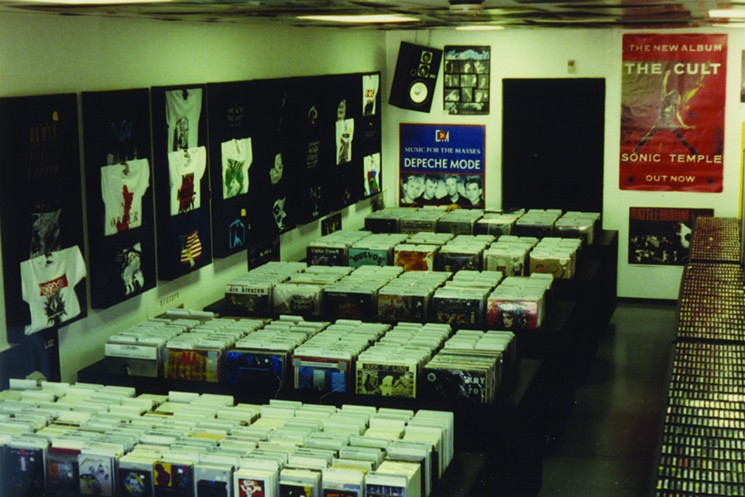
The interior of the original Stinkweeds in Mesa, which was open from 1987 to 1989.
Courtesy of Kimber Lanning
Lanning: People were patient. They liked us, so they would wait for us to order it in instead of getting it somewhere else. Of course, the climate was different and you couldn't order it online, you didn't have a whole lot of choice, but at the time there were other stores. Zia had two or three locations and Tower Records was booming.
Fries: They eventually poached me from Tower after I became friends with them and would be in the store once or twice a week. They just really liked the music and wanted to meet people and do things the way they thought it should be done.
Lanning: About a year and a half in, I decided I was no longer in love with Scott, and when I tried to unravel from him personally, he took it badly. So we had a pretty hard battle. He showed up one day with a huge U-Haul truck on a Saturday in front of everyone and threatened to take half of the stuff in the store.
Fries: That was one of the days I worked there that I remember vividly. Because I learned so much from both of them, especially Kimber, it was almost like they were my parents. I was a really good employee because I didn't want to disappoint her. So to see that happen it was very heavy. It really hurt to be there that day.
Lanning: I did exactly what [Scott] didn't expect me to do: I started grabbing stuff and throwing it in his U-Haul. And I said, "Great! You want half? You get the shitty stuff, too. Here's your crappy torn poster and here's your used [records].” And I just started putting stuff in the truck and he was like, "Woah! Woah! Why are you freaking out!?!" And I go, "I'm not freaking out, I'm giving you half the shit." [Laughs] I think he started to realize he’d went about it all wrong and actually didn't have claim to half the store. So he drove away that day with whatever I managed to throw in there. And then I didn't see him for years and years.
Fries: Kimber, of the two, was less emotional than Scott, but really wanted to just mercilessly draw a line right down the middle of everything, carefully load it up for him, say goodbye, and just start a new chapter. I got the feeling that it was very painful for her, it was just something that had to be done right and have it done fast. I could tell it was really tough on her through the whole thing.
Lanning: Around that time I decided to move the store to Dobson and Baseline. I sort of just wanted to start over and forget all of that.
Pawlicki: They connected with a crowd of kids out in Mesa who grew up buying at that store.
Lanning: Being near Dobson High, Corona Del Sol, and Marcos de Niza really kept us open.
Fries: A lot of our customers were kids from Dobson High. By the time me moved over to Baseline, we were seeing a wave of people from everywhere, but the strongest showing was high school kids from across the Valley.
Lindsay Cates, current Stinkweeds manager: I definitely remember discovering Stinkweeds before I could drive. It was a total anomaly and unlike anything that I’d ever seen or experienced. It was this tiny little store where everything was cool and awesome and handpicked and curated. I used to buy 7-inches because it was affordable and I didn't know anything. So I’d pick out whatever looked cool, whatever band name sounded cool, and go home with a single for three or four bucks. Some of it was great, some of it sucked, but all of it ended up being collector’s items.
Fries: There were kids coming in that became a lot of bands. The Wall brothers who became Kerosene 454, they were regulars. Trent [Martin] who owns Cowtown Skateboards, he was a Dobson High kid and a regular. And the guys from Jimmy Eat World came in.
Jim Adkins, singer and guitarist, Jimmy Eat World: One of the first destinations I would go in the family minivan was the record store. I think I was like 16 when I started going to Stinkweeds at Dobson and Baseline. Maybe I heard about it from the scary older kids that were already listening to Sisters of Mercy and they'd clued me into it. When Stinkweeds was at that location it was kind of the beginning of the period of playing in bands and exploring on your own what independent artists were doing. It's just a physical hub for trying to connect with people in the local scene. I guess as I got more into that, the store was just an integral stop and hang out for that period.
Clay Holley, former Stinkweeds employee: I worked there for about six years in the mid-to-late '90s. It was the job to have. I actually had people get mad at me because I got it, because so many others wanted that job. It was very desirable.
Cates: I vividly remember any interaction with any Stinkweeds employee or staff member. Hank was so sweet. He was so soft-spoken and knew so much about genres I didn't know anything about. And Kimber was, by far, the coolest record store owner and coolest lady.
Mike Genz, owner, King of the Monsters Records: I begged my mom to drive me out to Dobson to check this store out I had heard about. My first visit to Stinkweeds was like entering the gates of record heaven. Kimber was always so friendly, helpful and knew so much about everything she carried that I kept coming back to pick her brain on what records I should pick up next. She never steered me wrong.
Jonathan L.: Talking with Kimber was always great. We'd always have conversations when I'd come in, it wasn't like I walked in like a customer. She knew me and I knew her. I remember when she took up [kenpo] because she was this tiny little person and I said, "Why are you doing that?" and she said, "I want to protect myself." And I admire her for that. Kimber was always her own person.
Michael Ledington, operations manager, Zia Records: I used to special order a fair amount of items from Kimber, both myself and [late Zia owner] Brian Faber. And we were in there one day for this item she'd special ordered for us, this gigantic box set of Iron Maiden CD singles, and she was explaining how it was part of a multi-series set. And then all of a sudden, she stopped, put both hands on the counter, and just leaped over and ran out the door. And we were like, "What the hell?"
There had been another guy in the store who we weren't paying attention to and she was watching the whole time. And he’d attempted to walk out with some merchandise and she ran out and all but tackled this guy. Like got on his back and grabbed him. And Kimber basically gets her merchandise back after tussling with the guy, comes back inside with this pissed-off look on her face, straightens herself up, and picks right up from where she left off with us without breaking her stride.
Cates: I think that might've happened more than once. She's passionately pursued instances that she's witnessed. She wouldn't think twice about it. In fact, this one time these two kids stole something, I ran after them and she said, "Lindsay, stop, it's not worth it." And then she took off after them herself. She’s fast.
Read on for more of our oral history of Stinkweeds.
In 1995, Lanning decided to move Stinkweeds again, this time to a larger location on Apache Boulevard in Tempe, due to changes in the local record store scene.
Lanning: The industry really started to change. Best Buy moved into town around then, and I realized if I was going to survive, I really needed to make an effort to avoid what the [big box] stores were doing. I couldn’t try carrying a dozen Cure CDs when Best Buy had the same ones. So we’d focus on rare imports and really dig into the underground and American indie rock at the time, labels like Quarterstick or Touch and Go, because the bigger stores weren't going to mess with it. We moved because I thought that being in Tempe and closer to [ASU] might increase our capacity to reach people who wanted an underground store.
Adkins: When it migrated over there, I was living in the Tempe area and it became a quick stop.
Pawlicki: There was a time all the stores, we all carried the same things for a little bit, then we went into separate areas completely. We did more punk rock and hip-hop and whatnot and she went more into the the indie rock. We had some crossover, of course, but she worked more of what she was into, which was kind of the artier end of indie rock.
Stephen Chilton, owner, Psyko Steve Presents and The Rebel Lounge: I was at Stinkweeds in Tempe every week buying lots of stuff. A lot of what Kimber had wasn't at Best Buy. Some of it wasn’t even at Zia. Whereas nowadays, you hear about bands and check them out on Spotify, back then it was like, "Hey, I've heard about this one band, no one else has the record, I should get it from Stinkweeds."
Robin Vining, local musician and songwriter: Everything was just big and bright at places like Tower Records and Best Buy. And then there's this weird little place where they had all these specialty things or things that were hard to find.
Mary Papenhausen, promotions and marketing director, Zia Records: The selection was an education, to me at least, because I was used to a little more mainstream music. And going to the "B" section and not finding the Beatles but finding Beulah instead. I just remember going to the Tempe store and thinking, “Wow, this is awesome.” It was different because there's a lady running the store, which was something I’d never seen before.
Jonathan L.: There was a time there in the '90s when I’m pretty sure that Kimber was one of only a few female record store owners in the country.
Lanning: The entire time we were in Tempe we had tons of shows, like three to five a week probably. And that was a great time. We had some pretty amazing bands come and play at the store. Some of the standouts in my mind are Neutral Milk Hotel, Don Caballero, Cold Cold Hearts, Elliott Smith ... just a never-ending list of great bands that came through.
Holley: I think Elliot Smith played Stinkweeds twice [in '96 and '97] and the thing I remember about those shows was that he was in a better place at that point. I think this was pre-Good Will Hunting, so everybody there was so respectful of him. You could hear a pin drop. It was so intimate.
Adkins: For a minute, I really got into taping shows there, I have a really good bootleg of Trans-Am.
Cates: I remember seeing Blonde Redhead, Pedro the Lion, Helium ... even Sleater-Kinney. The stage was up against a glass window and so they’d pulled a curtain; dunno if it was for the band’s privacy or to encourage people loitering outside to actually come in. But Sleater-Kinney was sold out, so for that they opened the curtain so that everyone outside could watch.
Holley: Kimber would give [bands] all the ticket money. She would do it just to support the scene. Even if maybe only 50 people came, they all paid, and all the money went straight to the band.
Lanning: I started having local art on the walls around that time. And it got to be where I was booked out two years in advance for that, and it led me to realize how much of a need there was for a creative outlet for people, which is what gave me the idea to open Modified Arts in 1999.
Chilton: Kimber's been like a big mentor for like forever, just going in and talking to her about bands and shows and music, back in 1998 or 1999 when I was still in high school. Early on, she was a huge source of info on what she thought of certain bands and if people would be into it or not.
Cates: [Stinkweeds] became a community and a community space for me, to meet up with friends that I had met at that store. Back then, that's what record stores were about, and it was definitely a space for creative people to come together to find out about their true passions in life and co-habitate together.
In 2003, Lanning purchased a retail space near Camelback Road and Central Avenue. After an extensive rehab, it became the current home of Stinkweeds.
Lanning: I had a meeting at Lux one day and was thinking, "Man, I'd really love to move the store to downtown Phoenix." So after leaving Lux, I decided to look around and see if I can find a cool place. And sitting at the stoplight at Central and Camelback, I looked over and saw a “for sale” sign in the window of this cute building with 1950s green tile on the front. And I thought, "Holy shit,” and called the number and the [owner] goes, "No way! I literally just put that sign up.” And we met up a few minutes later and started talking.
Dario Miranda, longtime Stinkweeds employee: It was a gamble, but she saw the potential. That's just who Kimber is. Looking back on it, it was such a smart decision. It's amazing to see how much this area has developed since Kimber came in.
Lanning: All these other people were also interested in the building and were offering him cash. And here I was saying, "Please wait. I really want this building, but I've still got to go talk to the bank. I don't even have a plan." And he goes, "That's okay. I really like you, so we're going to wait."
Cates: I'd been working for Stinkweeds for a year or two and I remember when she told me she’d found the Phoenix location. I was like, "You're crazy," because I didn't realize she'd been thinking about expanding to a second location. She called me up to meet her here to see the space, and it was perfect. So then we had two locations for a bit.
Lanning: I never wanted to have two stores, and but because I was in such a hurry to get the [Camelback location] and still had a while left on the lease in Tempe, that’s what we wound up with for about a year and a half.
Miranda: When I first started at Stinkweeds, I would open the Tempe store and drive what we call "transfers" over here and then close this store, so I was pretty much working open to close at both stores.
Cates: It was cool while it lasted, but it wasn't really feasible with everything else she had going on in her life [with Modified and Local First Arizona].
Lanning: The Tempe store was our biggest one, but when we moved over here, I thought, "I'm going to scale back" — because with the future of record stores being what it was at the time — "who knows?" I also think that it's important to note that I made a decision a long time ago that I was either going to do it my way or I wasn't going to do it at all. And I'm a music store and if I can't be that, then I'll just go away. I had no interest in selling skull-shaped salt and pepper shakers or whatever lifestyle stuff other stores sell to survive.
Miranda: There was a period [about a decade ago] where all these big stores were closing down. Wherehouse closed, Tower closed. There were still a lot of smaller stores around, but then everyone was talking how those stores were going to close.
Lanning: So many people have been consuming music differently, whether it was through streaming or digital downloads, that there was a lot of undue pressure put on the record stores a few years ago by journalists beating the drum about of the “death of the record store.”
Miranda: As much as the internet hurt a lot of record stores, it really did open up people to all the different kinds of music that are out there. And, while, yeah, we saw a bit of a dip during that, because of the kind of record store we are, that wasn't a big problem for us. We pulled through it. There never was a really bad year for us, because we were always seeing new faces.
Lanning: I guess my main thing is that I've been scrappy in the way that I've been able to make it all work. And the store's been [thriving]. I mean, 2015 was the best year ever in terms of business. Vinyl is huge, we sell tons of turntables. So we’re fortunate. Lindsay's been here 15 years and Dario just over 10. We're lean and mean and we have a really good reputation.
Correction: This post has been updated from its original version to reflect the correct spelling of Michael Ledington's name and add additional memories.

